
1 The Heidelberg Project is an outdoor art project in Detroit, Michigan. It was created in 1986 by artist Tyree Guyton and his grandfather Sam Mackey ("Grandpa Sam") as an outdoor art environment in the McDougall-Hunt neighborhood on the city's east side
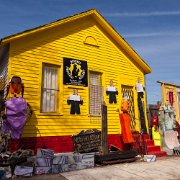
2 Tim Burke has been a leader in the outsider art movement in Detroit for the last 28 years. Mastering the found object genre. Tim has spearheaded a one man recycling operation and recover'd 10 tons of Granite from the renovation of the Detroit Institute of Arts. Many beautiful Terra Cotta pieces from the Riveara Theatre. travertine from the Detroit Collage of Law. as well as many more gone but not forgotten historic landmark buildings that have been torn down in Detroit over the last 25 years. Tim has turned some of these pieces into functional as well as surreal pieces of art . From a bench in the new Downtown Y.M.C.A. to tables and chairs that were being sold in the gift shop of the Detroit Institute of Arts. Tim's work has been shown locally as well as internationally. His website is www.detroitindustrialgallery.com He give stours of my place on the weekends friday saturday and sunday noon till 6pm. He can be reached at 313-742-1800
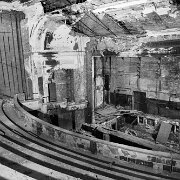
3 The 800-seat National Theater, built in 1911, is the only known theatre designed by Albert Kahn and the oldest surviving theatre from the city's original theatre district of the 19th century. It operated as a movie theater until the 1920s, when competition from larger movie houses forced a change to a vaudeville venue. The National survived as a burlesque and adult entertainment theater until it closed in the 1970s.
The front facade of the National is dominated by an enormous arch flanked with twin towers and covered with white and blue terra cotta tiles. The facade has hundreds of lightbulbs built in, which accentuate the architectural features when lit. The National Theater is an outstanding example of Modernistic design, boasting a pair of terra cotta latticework towers, arched art glass windows, and colored Pewabic tiles on the facade.
The front facade of the National is dominated by an enormous arch flanked with twin towers and covered with white and blue terra cotta tiles. The facade has hundreds of lightbulbs built in, which accentuate the architectural features when lit. The National Theater is an outstanding example of Modernistic design, boasting a pair of terra cotta latticework towers, arched art glass windows, and colored Pewabic tiles on the facade.
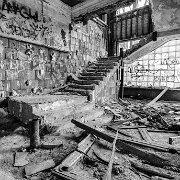
4 The Packard Pland, Detroit Michigan
The Packard Plant, located on East Grand Boulevard in Detroit, Michigan, was once a symbol of American industrial prowess. Opened in 1903 by the Packard Motor Car Company, the factory became one of the largest and most advanced automobile manufacturing plants of its time. Designed by the architect Albert Kahn, it was a sprawling complex covering over 40 acres, consisting of multiple buildings connected by an intricate system of railways and assembly lines. The plant was at the forefront of automotive innovation, producing luxury vehicles and employing thousands of workers. Throughout the early 20th century, Packard cars were synonymous with quality and craftsmanship, catering to an elite clientele. At its peak, the Packard Plant was a hub of activity, contributing significantly to Detroit’s status as the "Motor City."
However, the decline of the Packard Motor Car Company in the mid-20th century led to the eventual abandonment of the plant. By the 1950s, competition from other automakers, changing consumer tastes, and financial mismanagement led to Packard’s demise. In 1956, the company ceased operations at the plant, and the building fell into disrepair. Despite various attempts to revitalize the site, including plans for residential and commercial development, the Packard Plant remains a striking symbol of Detroit's industrial past. The site became an iconic ruin, attracting photographers, urban explorers, and those fascinated by the history of the automobile industry.
As of March 2025, all but 2 of the buildings have been demolished
The Packard Plant, located on East Grand Boulevard in Detroit, Michigan, was once a symbol of American industrial prowess. Opened in 1903 by the Packard Motor Car Company, the factory became one of the largest and most advanced automobile manufacturing plants of its time. Designed by the architect Albert Kahn, it was a sprawling complex covering over 40 acres, consisting of multiple buildings connected by an intricate system of railways and assembly lines. The plant was at the forefront of automotive innovation, producing luxury vehicles and employing thousands of workers. Throughout the early 20th century, Packard cars were synonymous with quality and craftsmanship, catering to an elite clientele. At its peak, the Packard Plant was a hub of activity, contributing significantly to Detroit’s status as the "Motor City."
However, the decline of the Packard Motor Car Company in the mid-20th century led to the eventual abandonment of the plant. By the 1950s, competition from other automakers, changing consumer tastes, and financial mismanagement led to Packard’s demise. In 1956, the company ceased operations at the plant, and the building fell into disrepair. Despite various attempts to revitalize the site, including plans for residential and commercial development, the Packard Plant remains a striking symbol of Detroit's industrial past. The site became an iconic ruin, attracting photographers, urban explorers, and those fascinated by the history of the automobile industry.
As of March 2025, all but 2 of the buildings have been demolished
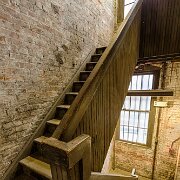
6 Ford Piquette Plant
In May 1904, after less than one year in operation, the board of the Ford Motor Company approved construction of a New England mill-style building, on a lot at the corner of Piquette and Beaubien Streets in Detroit, Michigan. The Detroit architectural firm of Smith, Hinchman, and Fields designed the building, which is three stories tall, 56 feet wide, and 402 feet long. The structure served the new firm for only a few years, yet it played a most important role in realizing Henry Ford's dream of an affordable car for the masses.
In May 1904, after less than one year in operation, the board of the Ford Motor Company approved construction of a New England mill-style building, on a lot at the corner of Piquette and Beaubien Streets in Detroit, Michigan. The Detroit architectural firm of Smith, Hinchman, and Fields designed the building, which is three stories tall, 56 feet wide, and 402 feet long. The structure served the new firm for only a few years, yet it played a most important role in realizing Henry Ford's dream of an affordable car for the masses.
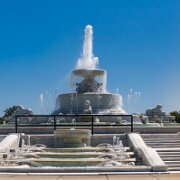
9 The James Scott Memorial Fountain in Detroit, Michigan, USA, was designed by architect Cass Gilbert and sculptor Herbert Adams. Located in Belle Isle Park, the fountain was completed in 1925 at a cost of $500,000. The lower bowl has a diameter of 510 ft (160 m) and the central spray reaches 125 ft (38 m). The fountain honors the controversial James Scott, who left $200,000 to the City of Detroit for a fountain in tribute to himself.
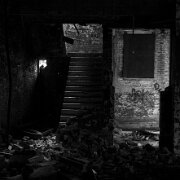
10 The Packard Pland, Detroit Michigan
The Packard Plant, located on East Grand Boulevard in Detroit, Michigan, was once a symbol of American industrial prowess. Opened in 1903 by the Packard Motor Car Company, the factory became one of the largest and most advanced automobile manufacturing plants of its time. Designed by the architect Albert Kahn, it was a sprawling complex covering over 40 acres, consisting of multiple buildings connected by an intricate system of railways and assembly lines. The plant was at the forefront of automotive innovation, producing luxury vehicles and employing thousands of workers. Throughout the early 20th century, Packard cars were synonymous with quality and craftsmanship, catering to an elite clientele. At its peak, the Packard Plant was a hub of activity, contributing significantly to Detroit’s status as the "Motor City."
However, the decline of the Packard Motor Car Company in the mid-20th century led to the eventual abandonment of the plant. By the 1950s, competition from other automakers, changing consumer tastes, and financial mismanagement led to Packard’s demise. In 1956, the company ceased operations at the plant, and the building fell into disrepair. Despite various attempts to revitalize the site, including plans for residential and commercial development, the Packard Plant remains a striking symbol of Detroit's industrial past. The site became an iconic ruin, attracting photographers, urban explorers, and those fascinated by the history of the automobile industry.
As of March 2025, all but 2 of the buildings have been demolished
The Packard Plant, located on East Grand Boulevard in Detroit, Michigan, was once a symbol of American industrial prowess. Opened in 1903 by the Packard Motor Car Company, the factory became one of the largest and most advanced automobile manufacturing plants of its time. Designed by the architect Albert Kahn, it was a sprawling complex covering over 40 acres, consisting of multiple buildings connected by an intricate system of railways and assembly lines. The plant was at the forefront of automotive innovation, producing luxury vehicles and employing thousands of workers. Throughout the early 20th century, Packard cars were synonymous with quality and craftsmanship, catering to an elite clientele. At its peak, the Packard Plant was a hub of activity, contributing significantly to Detroit’s status as the "Motor City."
However, the decline of the Packard Motor Car Company in the mid-20th century led to the eventual abandonment of the plant. By the 1950s, competition from other automakers, changing consumer tastes, and financial mismanagement led to Packard’s demise. In 1956, the company ceased operations at the plant, and the building fell into disrepair. Despite various attempts to revitalize the site, including plans for residential and commercial development, the Packard Plant remains a striking symbol of Detroit's industrial past. The site became an iconic ruin, attracting photographers, urban explorers, and those fascinated by the history of the automobile industry.
As of March 2025, all but 2 of the buildings have been demolished

11 The Packard Pland, Detroit Michigan
The Packard Plant, located on East Grand Boulevard in Detroit, Michigan, was once a symbol of American industrial prowess. Opened in 1903 by the Packard Motor Car Company, the factory became one of the largest and most advanced automobile manufacturing plants of its time. Designed by the architect Albert Kahn, it was a sprawling complex covering over 40 acres, consisting of multiple buildings connected by an intricate system of railways and assembly lines. The plant was at the forefront of automotive innovation, producing luxury vehicles and employing thousands of workers. Throughout the early 20th century, Packard cars were synonymous with quality and craftsmanship, catering to an elite clientele. At its peak, the Packard Plant was a hub of activity, contributing significantly to Detroit’s status as the "Motor City."
However, the decline of the Packard Motor Car Company in the mid-20th century led to the eventual abandonment of the plant. By the 1950s, competition from other automakers, changing consumer tastes, and financial mismanagement led to Packard’s demise. In 1956, the company ceased operations at the plant, and the building fell into disrepair. Despite various attempts to revitalize the site, including plans for residential and commercial development, the Packard Plant remains a striking symbol of Detroit's industrial past. The site became an iconic ruin, attracting photographers, urban explorers, and those fascinated by the history of the automobile industry.
As of March 2025, all but 2 of the buildings have been demolished
The Packard Plant, located on East Grand Boulevard in Detroit, Michigan, was once a symbol of American industrial prowess. Opened in 1903 by the Packard Motor Car Company, the factory became one of the largest and most advanced automobile manufacturing plants of its time. Designed by the architect Albert Kahn, it was a sprawling complex covering over 40 acres, consisting of multiple buildings connected by an intricate system of railways and assembly lines. The plant was at the forefront of automotive innovation, producing luxury vehicles and employing thousands of workers. Throughout the early 20th century, Packard cars were synonymous with quality and craftsmanship, catering to an elite clientele. At its peak, the Packard Plant was a hub of activity, contributing significantly to Detroit’s status as the "Motor City."
However, the decline of the Packard Motor Car Company in the mid-20th century led to the eventual abandonment of the plant. By the 1950s, competition from other automakers, changing consumer tastes, and financial mismanagement led to Packard’s demise. In 1956, the company ceased operations at the plant, and the building fell into disrepair. Despite various attempts to revitalize the site, including plans for residential and commercial development, the Packard Plant remains a striking symbol of Detroit's industrial past. The site became an iconic ruin, attracting photographers, urban explorers, and those fascinated by the history of the automobile industry.
As of March 2025, all but 2 of the buildings have been demolished

12 Chandler Elementary School was a school on the east side of Detroit, named for former mayor Zachariah Chandler. It was built in 1905, and like many other schools in the area was almost immediately overcrowded. From 1913 to 1914, the number of students grew from 1,600 to 2,362. While the number dropped the next year as more schools were opened nearby, admission continued to increase, and an additional wing was built in 1922. Another was built in 1961, but by then the population of the city had peaked, and enrollment was on its way down.
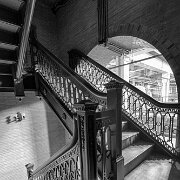
13 Detroit Water & Sewerage Department High Lift Building
Prior to 1880, the Board of Water Commissioners purchased a 56-acre tract on East Jefferson where the building you see is located. Shortly after 1900, it became clear that the area’s population and industrial activities were growing rapidly and that a vast amount of clean water would be needed. Indeed, by 1907, the city’s system was supplying an average of 160 gallons of water per day for every resident. Of course, much of that water was used by industries. Officials commissioned the Field, Hinchman and Smith firm to design a massive building for the pumps. The result is the very large, but appealing, High Lift building that you see.
Prior to 1880, the Board of Water Commissioners purchased a 56-acre tract on East Jefferson where the building you see is located. Shortly after 1900, it became clear that the area’s population and industrial activities were growing rapidly and that a vast amount of clean water would be needed. Indeed, by 1907, the city’s system was supplying an average of 160 gallons of water per day for every resident. Of course, much of that water was used by industries. Officials commissioned the Field, Hinchman and Smith firm to design a massive building for the pumps. The result is the very large, but appealing, High Lift building that you see.
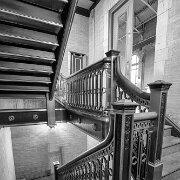
14 Detroit Water & Sewerage Department High Lift Building
Prior to 1880, the Board of Water Commissioners purchased a 56-acre tract on East Jefferson where the building you see is located. Shortly after 1900, it became clear that the area’s population and industrial activities were growing rapidly and that a vast amount of clean water would be needed. Indeed, by 1907, the city’s system was supplying an average of 160 gallons of water per day for every resident. Of course, much of that water was used by industries. Officials commissioned the Field, Hinchman and Smith firm to design a massive building for the pumps. The result is the very large, but appealing, High Lift building that you see.
Prior to 1880, the Board of Water Commissioners purchased a 56-acre tract on East Jefferson where the building you see is located. Shortly after 1900, it became clear that the area’s population and industrial activities were growing rapidly and that a vast amount of clean water would be needed. Indeed, by 1907, the city’s system was supplying an average of 160 gallons of water per day for every resident. Of course, much of that water was used by industries. Officials commissioned the Field, Hinchman and Smith firm to design a massive building for the pumps. The result is the very large, but appealing, High Lift building that you see.
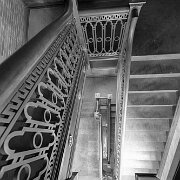
15 Detroit Water & Sewerage Department High Lift Building
Prior to 1880, the Board of Water Commissioners purchased a 56-acre tract on East Jefferson where the building you see is located. Shortly after 1900, it became clear that the area’s population and industrial activities were growing rapidly and that a vast amount of clean water would be needed. Indeed, by 1907, the city’s system was supplying an average of 160 gallons of water per day for every resident. Of course, much of that water was used by industries. Officials commissioned the Field, Hinchman and Smith firm to design a massive building for the pumps. The result is the very large, but appealing, High Lift building that you see.
Prior to 1880, the Board of Water Commissioners purchased a 56-acre tract on East Jefferson where the building you see is located. Shortly after 1900, it became clear that the area’s population and industrial activities were growing rapidly and that a vast amount of clean water would be needed. Indeed, by 1907, the city’s system was supplying an average of 160 gallons of water per day for every resident. Of course, much of that water was used by industries. Officials commissioned the Field, Hinchman and Smith firm to design a massive building for the pumps. The result is the very large, but appealing, High Lift building that you see.

19 The Pointe aux Barques Lighthouse ranks among the ten oldest lighthouses in Michigan. It is an active lighthouse maintained by the US Coast Guard remotely, located in Lighthouse County Park on Lake Huron near Port Hope, Michigan in Huron County. "Pointe aux Barques" means 'Point of Little Boats', a descriptor of the shallow shoals and reefs that lurk beneath these waves, presenting a hazard to boats as they round Michigan's Thumb



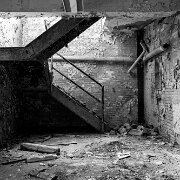



Stairs